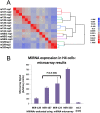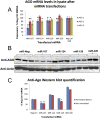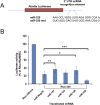Anti-Argonaute RIP-Chip shows that miRNA transfections alter global patterns of mRNA recruitment to microribonucleoprotein complexes
- PMID: 20042474
- PMCID: PMC2811668
- DOI: 10.1261/rna.1905910
Anti-Argonaute RIP-Chip shows that miRNA transfections alter global patterns of mRNA recruitment to microribonucleoprotein complexes
Abstract
MicroRNAs (miRNAs) play key roles in gene expression regulation by guiding Argonaute (AGO)-containing microribonucleoprotein (miRNP) effector complexes to target polynucleotides. There are still uncertainties about how miRNAs interact with mRNAs. Here we employed a biochemical approach to isolate AGO-containing miRNPs from human H4 tumor cells by co-immunoprecipitation (co-IP) with a previously described anti-AGO antibody. Co-immunoprecipitated (co-IPed) RNAs were subjected to downstream Affymetrix Human Gene 1.0 ST microarray analysis. During rigorous validation, the "RIP-Chip" assay identified target mRNAs specifically associated with AGO complexes. RIP-Chip was performed after transfecting brain-enriched miRNAs (miR-107, miR-124, miR-128, and miR-320) and nonphysiologic control miRNA to identify miRNA targets. As expected, the miRNA transfections altered the mRNA content of the miRNPs. Specific mRNA species recruited to miRNPs after miRNA transfections were moderately in agreement with computational target predictions. In addition to recruiting mRNA targets into miRNPs, miR-107 and to a lesser extent miR-128, but not miR-124 or miR-320, caused apparent exclusion of some mRNAs that are normally associated with miRNPs. MiR-107 and miR-128 transfections also result in decreased AGO mRNA and protein levels. However, AGO mRNAs were not recruited to miRNPs after either miR-107 or miR-128 transfection, confirming that miRNAs may alter gene expression without stable association between particular mRNAs and miRNPs. In summary, RIP-Chip assays constitute an optimized, validated, direct, and high-throughput biochemical assay that provides data about specific miRNA:mRNA interactions, as well as global patterns of regulation by miRNAs.
Figures









Similar articles
-
Individual microRNAs (miRNAs) display distinct mRNA targeting "rules".RNA Biol. 2010 May-Jun;7(3):373-80. doi: 10.4161/rna.7.3.11693. RNA Biol. 2010. PMID: 20421741 Free PMC article.
-
Specific sequence determinants of miR-15/107 microRNA gene group targets.Nucleic Acids Res. 2011 Oct;39(18):8163-72. doi: 10.1093/nar/gkr532. Epub 2011 Jun 30. Nucleic Acids Res. 2011. PMID: 21724616 Free PMC article.
-
Isolation of microRNA targets by miRNP immunopurification.RNA. 2007 Aug;13(8):1198-204. doi: 10.1261/rna.563707. Epub 2007 Jun 25. RNA. 2007. PMID: 17592038 Free PMC article.
-
miRNPs: versatile regulators of gene expression in vertebrate cells.Biochem Soc Trans. 2009 Oct;37(Pt 5):931-5. doi: 10.1042/BST0370931. Biochem Soc Trans. 2009. PMID: 19754429 Review.
-
High-throughput experimental studies to identify miRNA targets directly, with special focus on the mammalian brain.Brain Res. 2010 Jun 18;1338:122-30. doi: 10.1016/j.brainres.2010.03.108. Epub 2010 Apr 7. Brain Res. 2010. PMID: 20380813 Free PMC article. Review.
Cited by
-
Genomics and proteomics in solving brain complexity.Mol Biosyst. 2013 Jul;9(7):1807-21. doi: 10.1039/c3mb25391k. Epub 2013 Apr 24. Mol Biosyst. 2013. PMID: 23615871 Free PMC article. Review.
-
MiR-221 promotes the development of androgen independence in prostate cancer cells via downregulation of HECTD2 and RAB1A.Oncogene. 2014 May 22;33(21):2790-800. doi: 10.1038/onc.2013.230. Epub 2013 Jun 17. Oncogene. 2014. PMID: 23770851 Free PMC article.
-
Multiple microRNAs within the 14q32 cluster target the mRNAs of major type 1 diabetes autoantigens IA-2, IA-2β, and GAD65.FASEB J. 2015 Oct;29(10):4374-83. doi: 10.1096/fj.15-273649. Epub 2015 Jul 6. FASEB J. 2015. PMID: 26148972 Free PMC article.
-
MicroRNAs in the Stressed Heart: Sorting the Signal from the Noise.Cells. 2014 Aug 5;3(3):778-801. doi: 10.3390/cells3030778. Cells. 2014. PMID: 25100019 Free PMC article. Review.
-
miR-1 inhibits progression of high-risk papillomavirus-associated human cervical cancer by targeting G6PD.Oncotarget. 2016 Dec 27;7(52):86103-86116. doi: 10.18632/oncotarget.13344. Oncotarget. 2016. PMID: 27861141 Free PMC article.
References
Publication types
MeSH terms
Substances
Grants and funding
LinkOut - more resources
Full Text Sources
Research Materials
Miscellaneous
